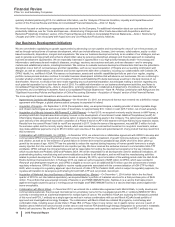Pfizer 2015 Annual Report Download - page 19
Download and view the complete annual report
Please find page 19 of the 2015 Pfizer annual report below. You can navigate through the pages in the report by either clicking on the pages listed below, or by using the keyword search tool below to find specific information within the annual report.
Financial Review
Pfizer Inc. and Subsidiary Companies
18
2015 Financial Report
Some of the more significant estimates and assumptions inherent in the estimate of the fair value of identifiable intangible assets include all
assumptions associated with forecasting product profitability from the perspective of a market participant.
Specifically:
• Revenue—We use historical, forecast, industry or other sources of market data including estimates of sales volume, selling prices, market
penetration, market share and year-over-year growth rates over the product’s life cycle.
• Cost of sales, Sales and marketing expenses, General and administrative expenses—We use historical, forecast, industry or other
sources of market data to estimate the costs associated with the identifiable intangible asset over the product’s life cycle.
• R&D expenses—In the case of approved products, we estimate the appropriate level of ongoing R&D support, and for unapproved
compounds, we estimate the amount and timing of costs to develop the R&D into viable products.
• Estimated life of the asset—We assess the asset’s life cycle and the competitive trends impacting the asset, including consideration of any
technical, legal, regulatory or economic barriers to entry, expected changes in standards of practice for indications addressed by the asset,
as well as obsolescence factors and estimated contract renewal rates.
• Inherent risk—We use a discount rate that is primarily based on the weighted-average cost of capital with an additional premium to reflect
the risks associated with the specific intangible asset, such as country risks (political, inflation, currency and property risks) and
commercial risks. In addition, for unapproved assets, an additional risk factor is added for the risk of technical and regulatory success,
called the probability of technical and regulatory success (PTRS).
• The discount rates used in the intangible asset valuations ranged from 11% to 16%, and the estimated cash flows were projected over
periods extending up to 20 years or more. For IPR&D assets, the PTRS rates ranged from 44% to 88%. Within this broad range, we
recorded approximately $20 million of assets with a PTRS of 44%, $220 million of assets with a PTRS of 45% to 75% and $755 million of
assets with a PTRS above 75% ($585 million after the write-off of the acquired biosimilar IPR&D assets discussed above). All of these
judgments and estimates can materially impact our results of operations.
For IPR&D assets, the risk of failure has been factored into the fair value measure and there can be no certainty that these assets ultimately
will yield a successful product.
Contingencies—For acquisition date contingencies, see Notes to Consolidated Financial Statements––Note 2. Acquisitions, Licensing
Agreements, Collaborative Arrangements, Divestitures, Equity-Method Investments and Cost-Method Investment: Acquisitions.
























